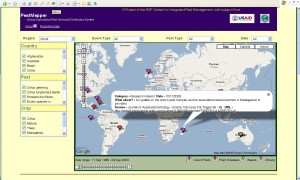![]() We’re used to thinking — or at least assuming — in agrobiodiversity conservation that genetic distance is a monotonically increasing function of geographic distance. It is, after all, a reflection of the great Waldo Tobler’s First Law of Geography: “Everything is related to everything else, but near things are more related than distant things.” And yet. Why should that necessarily be so for crops and livestock, so willfully and incessantly moved to and fro by people in all kinds of unpredictable ways?
We’re used to thinking — or at least assuming — in agrobiodiversity conservation that genetic distance is a monotonically increasing function of geographic distance. It is, after all, a reflection of the great Waldo Tobler’s First Law of Geography: “Everything is related to everything else, but near things are more related than distant things.” And yet. Why should that necessarily be so for crops and livestock, so willfully and incessantly moved to and fro by people in all kinds of unpredictable ways?
A paper just out in Molecular Ecology in effect tests the First Law of Geography with goat genetic diversity data, microsatellites in fact. ((BERTHOULY, C., DO NGOC, D., THÉVENON, S., BOUCHEL, D., NHU VAN, T., DANES, C., GROSBOIS, V., HOANG THANH, H., VU CHI, C., & MAILLARD, J. (2009). How does farmer connectivity influence livestock genetic structure? A case-study in a Vietnamese goat population Molecular Ecology DOI: 10.1111/j.1365-294X.2009.04342.x)). Goat populations were sampled in 3-8 villages in each of 2-5 communes in each of 10 districts in the remote, mountainous, ethnically mixed Vietnamese province of Hang Giang, for a total of 492 animals. The genetic relationships among the animals were then analyzed.
To the surprise of the authors, the spatial structure of the overall population was poorly explained by simple geographic distance. The ethnicity of their keepers and the husbandry practices to which they were subjected did a much better job of predicting the genetic distance between goats. The most dissimilar goats were not necessarily the ones which lived furthest apart, but rather the ones which were kept in different ways by people of different ethnic groups.
So, if you wanted to maximise the diversity in a Vietnamese goat conservation programme, or your chances of hybrid vigour, you’d pick animals from different ethnic groups or production systems, and not necessarily from different ends of the country. Which is something that I remember sort of almost subconsciously doing when I was collecting crops, but it is nice to see it validated like this. I can’t remember offhand similar work on crops, but no doubt Jacob will set me straight soon enough. In the meantime, I revel in a rule proven.
